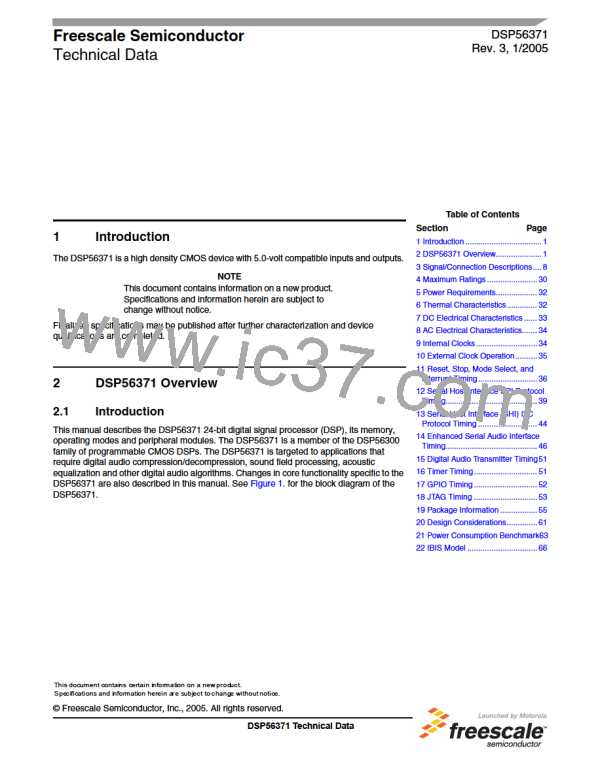DSP56371 Overview
2.4.2
Address Generation Unit (AGU)
The AGU performs the effective address calculations using integer arithmetic necessary to address data operands in memory
and contains the registers used to generate the addresses. It implements four types of arithmetic: linear, modulo, multiple wrap-
around modulo and reverse-carry. The AGU operates in parallel with other chip resources to minimize address-generation
overhead.
The AGU is divided into two halves, each with its own Address ALU. Each Address ALU has four sets of register triplets, and
each register triplet is composed of an address register, an offset register and a modifier register. The two Address ALUs are
identical. Each contains a 24-bit full adder (called an offset adder).
A second full adder (called a modulo adder) adds the summed result of the first full adder to a modulo value that is stored in its
respective modifier register. A third full adder (called a reverse-carry adder) is also provided.
The offset adder and the reverse-carry adder are in parallel and share common inputs. The only difference between them is that
the carry propagates in opposite directions. Test logic determines which of the three summed results of the full adders is output.
Each Address ALU can update one address register from its respective address register file during one instruction cycle. The
contents of the associated modifier register specifies the type of arithmetic to be used in the address register update calculation.
The modifier value is decoded in the Address ALU.
2.4.3
Program Control Unit (PCU)
The PCU performs instruction prefetch, instruction decoding, hardware DO loop control and exception processing. The PCU
implements a seven-stage pipeline and controls the different processing states of the DSP56300 core. The PCU consists of the
following three hardware blocks:
•
•
•
Program decode controller (PDC)
Program address generator (PAG)
Program interrupt controller
The PDC decodes the 24-bit instruction loaded into the instruction latch and generates all signals necessary for pipeline control.
The PAG contains all the hardware needed for program address generation, system stack and loop control. The Program
interrupt controller arbitrates among all interrupt requests (internal interrupts, as well as the five external requests: IRQA, IRQB,
IRQC, IRQD and NMI) and generates the appropriate interrupt vector address.
PCU features include the following:
•
•
•
•
•
•
Position independent code support
Addressing modes optimized for DSP applications (including immediate offsets)
On-chip instruction cache controller
On-chip memory-expandable hardware stack
Nested hardware DO loops
Fast auto-return interrupts
The PCU implements its functions using the following registers:
•
•
•
•
•
•
•
•
•
PC—program counter register
SR—Status register
LA—loop address register
LC—loop counter register
VBA—vector base address register
SZ—stack size register
SP—stack pointer
OMR—operating mode register
SC—stack counter register
The PCU also includes a hardware system stack (SS).
Freescale Semiconductor
DSP56371 Technical Data
5

 FREESCALE [ Freescale ]
FREESCALE [ Freescale ]